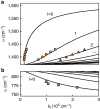Subdiffractional focusing and guiding of polaritonic rays in a natural hyperbolic material
- PMID: 25902364
- PMCID: PMC4421822
- DOI: 10.1038/ncomms7963
Subdiffractional focusing and guiding of polaritonic rays in a natural hyperbolic material
Abstract
Uniaxial materials whose axial and tangential permittivities have opposite signs are referred to as indefinite or hyperbolic media. In such materials, light propagation is unusual leading to novel and often non-intuitive optical phenomena. Here we report infrared nano-imaging experiments demonstrating that crystals of hexagonal boron nitride, a natural mid-infrared hyperbolic material, can act as a 'hyper-focusing lens' and as a multi-mode waveguide. The lensing is manifested by subdiffractional focusing of phonon-polaritons launched by metallic disks underneath the hexagonal boron nitride crystal. The waveguiding is revealed through the modal analysis of the periodic patterns observed around such launchers and near the sample edges. Our work opens new opportunities for anisotropic layered insulators in infrared nanophotonics complementing and potentially surpassing concurrent artificial hyperbolic materials with lower losses and higher optical localization.
Conflict of interest statement
F.K. is one of the co-founders of Neaspec and Lasnix, producer of the s-SNOM and infrared source used in this work. The remaining authors declare no competing financial interests.
Figures





References
-
- Pendry J. B. Negative refraction makes a perfect lens. Phys. Rev. Lett. 85, 3966–3969 (2000). - PubMed
-
- Fang N., Lee H., Sun C. & Zhang X. Sub-diffraction-limited optical imaging with a silver superlens. Science 308, 534–537 (2005). - PubMed
-
- Taubner T., Korobkin D., Urzhumov Y., Shvets G. & Hillenbrand R. Near-field microscopy through a SiC superlens. Science 313, 1595 (2006). - PubMed
-
- Zhang X. & Liu Z. Superlenses to overcome the diffraction limit. Nat. Mater. 7, 435–441 (2008). - PubMed
-
- Smolyaninov I. I., Hung Y. J. & Davis C. C. Magnifying superlens in the visible frequency range. Science 315, 1699–1701 (2007). - PubMed
Publication types
LinkOut - more resources
Full Text Sources
Other Literature Sources
Molecular Biology Databases

